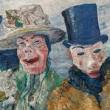The Iconic “The Scream” Painting: A Symbol of Anguish and Anxiety
One of the most famous and recognizable works of art in the world, Edvard Munch’s painting “The Scream” continues to captivate audiences with its haunting depiction of anguish and anxiety. Created in 1893, this masterpiece is a powerful representation of the human experience, resonating with viewers on a deep emotional level.
The central figure in the painting, with a contorted face and hands pressed against the ears, appears to be screaming in despair. The swirling colors and distorted forms in the background further intensify the sense of chaos and turmoil. Munch’s use of bold lines and vivid hues creates a sense of unease and tension, drawing the viewer into the emotional turmoil depicted on canvas.
“The Scream” is often interpreted as a reflection of Munch’s own inner struggles with mental health and existential angst. The painting captures a moment of intense emotional crisis, conveying feelings of isolation, alienation, and existential dread. Its universal themes resonate with people from all walks of life, making it a timeless symbol of human suffering and vulnerability.
Over the years, “The Scream” has become an iconic image that transcends its original context to become a symbol of modern anxiety and uncertainty. It has inspired countless artists, writers, and filmmakers who have sought to explore themes of existential despair and psychological turmoil in their own work.
Despite being over a century old, “The Scream” continues to speak to contemporary audiences, reminding us of the enduring power of art to evoke raw emotions and provoke deep introspection. Its ability to capture the essence of human suffering makes it not just a painting but a profound meditation on the human condition.
5 Insights into Edvard Munch’s Iconic ‘The Scream’ Painting
- The Scream painting was created by Edvard Munch in 1893.
- It is an iconic expressionist painting that depicts a figure screaming on a bridge.
- The painting is known for its vibrant colors and emotional intensity.
- There are several versions of The Scream, including paintings, pastels, and prints.
- The artwork has been interpreted as symbolizing the anxiety and existential dread of modern life.
The Scream painting was created by Edvard Munch in 1893.
The iconic painting “The Scream” was created by the Norwegian artist Edvard Munch in 1893. This masterpiece, with its striking depiction of a figure in distress against a swirling, vividly colored background, has become a symbol of anguish and existential anxiety. Munch’s use of bold lines and intense colors captures the raw emotion and inner turmoil experienced by the central figure, resonating with viewers on a profound emotional level. Created over a century ago, “The Scream” continues to captivate audiences worldwide with its timeless portrayal of human suffering and vulnerability.
It is an iconic expressionist painting that depicts a figure screaming on a bridge.
The tip on the iconic “The Scream” painting describes it as a quintessential expressionist artwork portraying a figure screaming on a bridge. This powerful image captures the intense emotional turmoil and inner anguish experienced by the central figure, depicted through distorted forms and vivid colors. The painting’s evocative portrayal of raw emotion and psychological distress has cemented its status as a timeless masterpiece that continues to resonate with viewers worldwide, inviting contemplation on themes of existential dread and human vulnerability.
The painting is known for its vibrant colors and emotional intensity.
“The Scream” painting by Edvard Munch is renowned for its vibrant colors and emotional intensity, which together create a striking visual impact. The bold and vivid hues used in the artwork contribute to its powerful expression of anguish and anxiety, drawing viewers into the raw emotion portrayed on the canvas. Munch’s masterful use of color enhances the painting’s overall intensity, making it a captivating and emotionally charged piece that continues to resonate with audiences worldwide.
There are several versions of The Scream, including paintings, pastels, and prints.
The iconic painting “The Scream” by Edvard Munch exists in several versions, showcasing the artist’s exploration of different mediums and techniques. Alongside the well-known painted version, Munch also created variations of “The Scream” using pastels and prints. Each iteration offers a unique perspective on the haunting subject matter, allowing viewers to experience the emotional intensity of the artwork in diverse ways. The various versions of “The Scream” highlight Munch’s versatility as an artist and his commitment to capturing the essence of anguish and anxiety through different artistic mediums.
The artwork has been interpreted as symbolizing the anxiety and existential dread of modern life.
The iconic painting “The Scream” by Edvard Munch has been widely interpreted as symbolizing the anxiety and existential dread of modern life. The haunting depiction of a figure in distress, with a contorted face and hands pressed against the ears, resonates with viewers as a powerful representation of the emotional turmoil and inner struggles that many individuals face in today’s fast-paced and uncertain world. The swirling colors and distorted forms in the background further enhance the sense of chaos and unease, capturing the universal themes of isolation, alienation, and existential despair that continue to be relevant in contemporary society.




